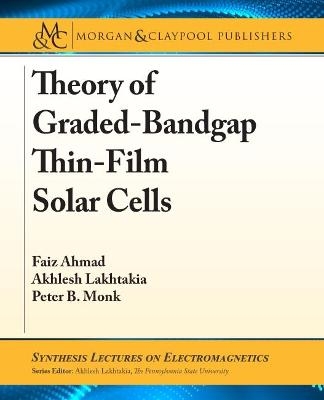
Theory of Graded-Bandgap Thin-Film Solar Cells
Seiten
2021
Morgan & Claypool Publishers (Verlag)
978-1-63639-216-5 (ISBN)
Morgan & Claypool Publishers (Verlag)
978-1-63639-216-5 (ISBN)
An optoelectronic model is formulated and implemented along with the differential evolution algorithm to assess the efficacy of grading the bandgap of the CIGS, CZTSSe, and AlGaAs photon-absorbing layer for optimizing the power-conversion efficiency of thin-film CIGS, CZTSSe, and AlGaAs solar cells in the two-terminal single-junction format.
Thin-film solar cells are cheap and easy to manufacture but require improvements as their efficiencies are low compared to that of the commercially dominant crystalline-silicon solar cells. An optoelectronic model is formulated and implemented along with the differential evolution algorithm to assess the efficacy of grading the bandgap of the CIGS, CZTSSe, and AlGaAs photon-absorbing layer for optimizing the power-conversion efficiency of thin-film CIGS, CZTSSe, and AlGaAs solar cells, respectively, in the two-terminal single-junction format. Each thin-film solar cell is modeled as a photonic device as well as an electronic device. Solar cells with two (or more) photon-absorbing layers can also be handled using the optolelectronic model, whose results will stimulate experimental techniques for bandgap grading to enable ubiquitous small-scale harnessing of solar energy.
Thin-film solar cells are cheap and easy to manufacture but require improvements as their efficiencies are low compared to that of the commercially dominant crystalline-silicon solar cells. An optoelectronic model is formulated and implemented along with the differential evolution algorithm to assess the efficacy of grading the bandgap of the CIGS, CZTSSe, and AlGaAs photon-absorbing layer for optimizing the power-conversion efficiency of thin-film CIGS, CZTSSe, and AlGaAs solar cells, respectively, in the two-terminal single-junction format. Each thin-film solar cell is modeled as a photonic device as well as an electronic device. Solar cells with two (or more) photon-absorbing layers can also be handled using the optolelectronic model, whose results will stimulate experimental techniques for bandgap grading to enable ubiquitous small-scale harnessing of solar energy.
Preface
Acknowledgments
Acronyms and Symbols
Introduction
Solar-Cell Optics
Solar-Cell Electronics
Homogeneous Photon-Absorbing Layer
Linearly Graded Photon-Absorbing Layer
Nonlinearly Graded Photon-Absorbing Layer
Authors' Biographies
| Erscheinungsdatum | 16.09.2021 |
|---|---|
| Reihe/Serie | Synthesis Lectures on Electromagnetics |
| Verlagsort | San Rafael |
| Sprache | englisch |
| Maße | 191 x 235 mm |
| Gewicht | 333 g |
| Themenwelt | Naturwissenschaften ► Physik / Astronomie ► Elektrodynamik |
| Technik ► Elektrotechnik / Energietechnik | |
| ISBN-10 | 1-63639-216-4 / 1636392164 |
| ISBN-13 | 978-1-63639-216-5 / 9781636392165 |
| Zustand | Neuware |
| Haben Sie eine Frage zum Produkt? |
Mehr entdecken
aus dem Bereich
aus dem Bereich
eine Einführung in die Gleich- und Wechselstromtechnik
Buch | Hardcover (2024)
Hanser (Verlag)
34,99 €
Grundlagen und praktische Anwendungen
Buch | Hardcover (2022)
Hanser (Verlag)
34,99 €


